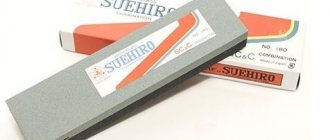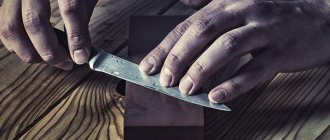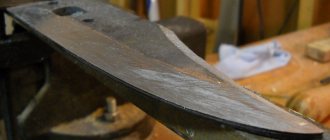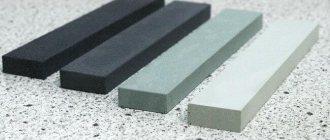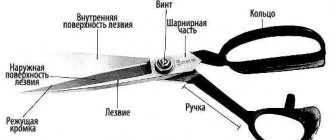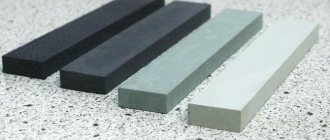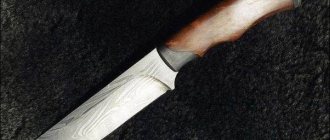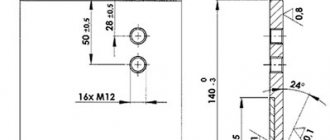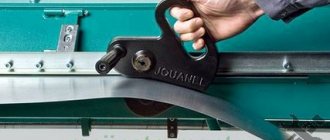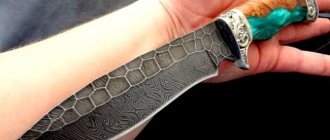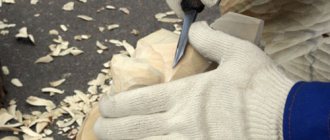Musat is a sharpening tool that is used both by professionals and at home. With its help, you can sharpen knives, straighten blades, and can be used daily without damaging the metal of the cutting tool. There are diamond, ceramic and steel musats; each type has individual advantages and some disadvantages.
The cost of musats ranges from 100-5000 thousand rubles; ceramic ones are considered the most expensive. You can make a tool yourself (from an electrode), but experts say that this is not advisable - the sharpening quality is low and the service life is short.
What is musat, what is it for?
Musat is a special device that is used for straightening knives; it is needed to keep the edge of the blade always sharp. It is an imitation of a round file with a handle. The main feature of musat is that when editing a knife, shavings are not removed from the metal, the surface of the blade remains unchanged, which extends the life of the cutting tool. It is important that the hardness of the metal of the sharpening tool exceeds that of the knife.
Knife musats, depending on the area of use, are divided into three large groups:
| Household | These are the cheapest tools, having a length of only 180-230 mm. Used for sharpening ordinary kitchen knives, which have a “soft” blade metal. |
| Universal | Much better in quality and more expensive than household ones, they have a “rod” length of 260-290 mm. Excellent for working with hard blades. |
| Professional | Their main difference is their size: the length of the “rod” is 260-360 mm. If you need to prepare a knife for cutting meat, then you should use thin musat, the length of which is 320-360 mm. Professional chefs prefer a tool with a thicker “rod” (260 mm). |
Grinding
Finishing and straightening a knife is the most important stage of sharpening, which involves grinding and polishing the metal. For these purposes, musat, sandpaper, abrasive paste, polishing cloth and a mixture are usually used.
The grinding and polishing technology is as follows:
- Holding the knife firmly in one hand, the edge of the blade is processed using musat.
- After finishing, sandpaper or abrasive paste can be used for a more accurate result. Abrasive paste is usually made from diamond sand.
- Then the mixture is applied to a polishing cloth and the final sharpened surface is processed. This procedure will take a lot of time manually; it is best to use a special polishing disc on which a special tape is put.
- The procedure is repeated several times with the replacement of the tape, from the largest caliber to the smallest.
It is worth noting that some knives are factory coated with a special coating. Such knives cannot be polished, otherwise the protective properties of the surface will be lost.
Types of musat for knives by material
When buying polish for knives, you should pay attention to the material from which it is made:
- ceramics;
- metal;
- diamond.
Depending on this parameter, the sharpening tool is used to work with different types of knives.
Ceramic
This kind of knife polish has a ceramic coating of different abrasiveness on the “rod” - on one side there are notches on the surface, on the other it is absolutely smooth. The first option is necessary for sharpening the blade, to give a sharp edge to the blade. But a smooth ceramic coating will be needed for finishing straightening the metal.
Ceramic musat is optimally suited for working with knives of low metal hardness. It should also be used for straightening wide blades and old, “worn out” cutting tools.
Ceramic musat
Diamond
Diamond musat is recognized as the best sharpening tool, because just a few movements are enough and even the hardest/largest knife will become sharp again. A tool with a diamond “rod” is not used for sharpening the blade; it can only be used to straighten and polish the metal.
Diamond musat is made from chrome-plated steel, with diamond particles sprayed on top. The tool is produced in an oval shape, which prevents the formation of nicks on the surface.
It is important to properly care for this type of musat:
- Be sure to rinse by hand under running water after use;
- dry naturally (do not wipe with a towel);
- Store separately from any solid objects.
Diamond musat
Steel, metal
Steel nuts are made from an alloy of chromium and vanadium; the main advantage of a metal tool is the maximum hardness of the “rod”. The surface is smooth, the tool is necessary for straightening and polishing the blade, but is never used as a sharpening device.
There are no special features in caring for metal musat; it is quite simple to keep it clean.
Fischer Éco round steel nut, chrome plated
Mixed
A mixed sharpening tool is one that has different surfaces: one smooth, the other with fine serrations. This musat can be used to sharpen, sharpen, and polish knives.
Most Popular Brands
- Apex edge pro is professional equipment designed for precise sharpening of any blades. This device is made in the USA. This sharpener has become very popular due to its reasonable cost and high quality.
- Ganzo is a well-known manufacturer of sharpening equipment and knives from China. Its products also have a high level of quality and low price.
- Lansky is a famous American company that specializes in the production of sharpening machines that are characterized by a very simple sharpening principle.
- Ruixin is a Chinese company. Installations from this manufacturer are somewhat cheaper than even those from Ganzo. However, before using sharpening equipment, sharpening stones should be trimmed each time.
What types of musats are there for sharpening knives by function?
Musats are used not only for sharpening knives, but also for polishing them. Moreover, the industry produces two types of tools, which differ in their functional “accessories”.
For grinding
Grinding musk can be:
- tubular;
- round;
- flat.
Forms of musats
The tool is used even for new knives, because the edge of the blade is not brought to perfection in production. Grinding musat is optimal for straightening kitchen knives whose sharpness level has simply decreased a little. It is impossible to fully sharpen a cutting tool with this type of device.
For initial sharpening
The most popular musats are those that are made of metal and have notches on their surface. The shape of the tool can be absolutely any, it is chosen individually - who is comfortable working with what.
For initial sharpening of knives, it is best to use a classic round steel grinder, the length of which ranges from 250-300 mm. It must be taken into account that this parameter should always be 50 mm greater than the length of the blade of the knife that needs to be sharpened.
Watch the video on how to sharpen a knife using musat:
The best manual sharpeners
There are quite a lot of hand tools; they can vary in material, shape and type of design. This selection includes several high-quality and convenient manual sharpening mechanisms.
NodobaBorda knife
The mechanism is like brass knuckles, but its holder is on the side. The tool is safer, more convenient and practical. The plastic body has two sharpening blades with the correct angle. The surface is metal, abrasive.
NodobaBorda knife.
Smiths Edgeware SM50044
A convenient device with a handle and two ceramic sharpening blades. The sharpener has a correctly set angle and is suitable for sharpening different types of tools. Abrasive surfaces can be easily removed and cleaned.
Smiths Edgeware SM50044 sharpener.
Three-zone Chefs Choice CC4623
Diamond coating and three sharpening zones allow you to achieve maximum blade sharpness in a short time. The sharpening blades have a correct angle of about 20 degrees and last a long time.
Chefs Choice CC4623 sharpener.
How to sharpen knives with musat on weight
Sharpening a knife with musat while hanging is carried out according to the following algorithm:
- Take a knife in your hand and place its blade downwards at the bottom of the musat. The cutting edge at this moment should be in the “away” position.
- The blade moves towards itself along the surface of the tool. It is important to maintain the angle of inclination.
- Several repetitions of the movements are performed - quickly, but without pressure.
- Turn the knife over with the blade facing you and repeat the process.
It’s not easy to sharpen knives while hanging with musat, but this is exactly how professional chefs use the tool. For the process to proceed correctly, three rules must be followed:
- The angle of inclination of the musat in relation to the knife blade should be strictly 20 degrees.
- Back-and-forth movements are performed at a fast pace.
- Jerking and too sharp “jerks” are strictly not allowed.
This method of sharpening knives is considered dangerous because there is a high probability of the blade jumping off the surface of the grinder and injuring the hands, even the stomach. To make the cutting tool sharp, it is enough to repeat the movements 5-6 times for each side of the blade. If the knife is very dull, then the number of repetitions increases by one and a half to two times.
You can also sharpen a completely new knife while hanging, for which you can maintain an angle of inclination of the grinder of 30 degrees. In this case, the movements of the blade are performed with light pressure and in the direction “away from you.”
How to use with support
It is much easier to use a grinder with a support; the sharpening process in this case will proceed in a clear sequence:
- The sharpening tool rests strictly vertically on a hard surface. To prevent it from slipping, it is recommended to place a towel.
- Already at the stop you need to position the tool at an angle of 20-25 degrees.
- The knife blade moves along the surface of the musat strictly perpendicularly.
- They begin the movement from the top - the base of the knife is adjacent to the sharpening tool, and end at the bottom - the tip of the blade is adjacent to the sharpening tool.
It is important to make movements only in one direction - from top to bottom; to repeat, the knife blade comes off the surface of the “rod”.
How to edit a knife
You can and should sharpen knives with musat every day so that the blade always remains sharp. The process is performed according to the same algorithm as sharpening a tool with a support, but with one difference - the tip of the knife is applied to the right to the upper part of the “rod”. Next, a downward movement is made and repeated 4-5 times for each side.
You can simplify the process and position the sharpening tool not vertically, but horizontally, slightly lifting it above the surface by the handle. After finishing work on editing the knife, be sure to wipe its blade from metal chips.
Watch the video on how to sharpen a knife with musat:
Features of use
In order to learn how to sharpen correctly, you need to find out which blade is considered correct. Under repeated magnification, the dull surface of the cutting edge of the knife looks very uneven and loose. Before using a tool, you need to assess the level of damage to its cutting part in order to choose a suitable abrasive material: a very dull device must first be corrected with coarse abrasive particles, and only then can you begin polishing. The operating principle differs for different types of sharpeners:
- musat - the blades move at a slight angle without significant pressure, which allows you to apply a minimum of effort;
- sharpening stone - you should sharpen starting from the area of the blade near the handle, smoothly moving to the very tip;
- mechanical type sharpener - with sharp and strong movements, the cutting element passes between the grinding stones.
How to choose musat for sharpening knives
You should choose musat for sharpening knives according to the clear recommendations of experts:
- if the coating of the “rod” is diamond, then no dust or small crumbs should fall off it - just rub it with your finger to ensure the quality of the tool;
- ceramic musat should not have visible damage - scratches, chips;
- High-quality steel models are distinguished by uniform metal density - there should be no roughness on the surface of the “rod”.
It is highly desirable that a magnet be “built-in” at the tip of the sharpening tool. This improvement of the grinding cloth ensures the collection of metal dust during sharpening or straightening of knives.
Which is better - ceramic or steel?
It is believed that between ceramic and steel musat it is better to choose the first option:
- ceramic coating is durable;
- working with knives does not damage the metal.
But steel musat also has an important advantage - it is resistant to falls and impacts, while ceramics are damaged very easily.
Which professional do you choose?
Professional grinders are distinguished by their size - the length of the entire tool does not exceed 260 mm. Chefs claim that the surface of the “rod” should be polished as much as possible in order to see one’s own reflection in it. This means that you should pay attention to metal and steel sharpening tools.
If the choice is made to use musat in a regular kitchen, then it will be especially convenient with a thin rod, because it will be easy for them to sharpen both narrow and wide knives of different shapes.
How to properly care for a musat knife
The musat knife can be actively used for a long time, but for this you need to properly care for it:
- after use, the tool should be stored suspended - on a hook or in a special stand;
- You need to wash the musat with warm water, any detergent, but without abrasive particles in the composition;
- if the “rod” is diamond coated, then the tool should be stored separately from any other hard objects;
- Ceramic tools should not be dropped or knocked - even a small chip or shallow scratch makes it impossible to use the tool for its intended purpose.
The tool must be stored in a special stand
How to make musat from an electrode
If you wish, you can make this sharpening tool from an electrode with your own hands; to do this, you will need to follow the steps in the following order:
- Prepare a surfacing electrode, the most suitable ones will be from . Cut it to the required length (within 180-200 mm).
- Remove the top layer from the surface of the rod with a whetstone. It is worth using such a tool with a fine abrasive surface.
- A handle must be attached to one end of the electrode. It can be made of wood or plastic; in the latter case, it is recommended to use a ready-made screwdriver or any other suitable tool.
Homemade musat from an electrode is ineffective; it is suitable only for straightening kitchen knives, and this process will need to be carried out almost every day.
We recommend reading the article about types of knives. From it you will learn about the main types, shapes of knives, their names and characteristics, knife blade materials by type of metal, as well as the rules and selection criteria. And here is more information about knife stands.
Musats are used by both professional chefs and housewives. They are convenient for sharpening/sharpening any knives, you just need to make the right choice of tool. They have a long service life provided proper care and storage.
Criteria for selecting a sharpening tool
There are many criteria that can be applied to sharpening stones. Previously, hand power tools were used at home. But on the modern market there are electric machines that are convenient for home use.
So, in order to choose a sharpening machine or tool for household use, you need to take into account the material of the blade and the frequency of use of the knife. There are also many criteria that depend only on your own preferences: manufacturer, brand and even price category.
Useful video
Watch the video on how to make musat yourself:
Similar articles
- Whetstone: which one is better to choose based on grain size...
What is a whetstone, whetstone. How to choose the right one for kitchen knives, the best by manufacturer. What main parameters need to be taken into account - grain size, size, composition. What do water-based, oil-based, ceramic, abrasive stones mean? How to properly care for a sharpener. Is it possible to make it yourself and from what? Read more - Hunting knives: main and best types, sizes, how...
What are the best hunting knives for both professionals and beginners? What are the parameters of knives for hunting: sizes, sheaths, steel, shape. How to choose a knife, make it yourself. How much does a knife cost, how to buy a good one for hunting, fishing and tourism. Read more
- Knife stand: how to make it yourself...
What types of knife stands are there, is it different for kitchen, decorative, and souvenir ones. How you can make a knife stand with your own hands from plywood, with filler, decoupage according to the drawings. What are the differences between a shelf, stand, glass, brush stand, holder, their pros and cons. Read more
- Knife handle: depending on size, thickness, how...
What kind of knife handle can be based on the main indicators - thickness, size, method of decoration. How to make a handle for a knife, which drawing is suitable. How to attach a blade to a handle. Is there a knife without a handle? Read more
- Switchblade: main types - American, Soviet...
What kind of switchblade is there? What are the most popular types among Russian, Soviet, American manufacturers. Some knives with a secret, some frontal, push-button. Is it a melee weapon or not? What are the advantages of an automatic switchblade. Read more
